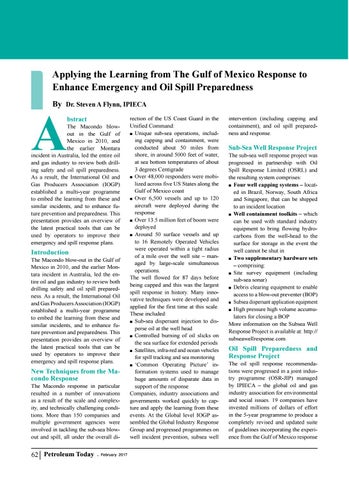Applying the Learning from The Gulf of Mexico Response to Enhance Emergency and Oil Spill Preparedness By Dr. Steven A Flynn, IPIECA
A
bstract
The Macondo blowout in the Gulf of Mexico in 2010, and the earlier Montara incident in Australia, led the entire oil and gas industry to review both drilling safety and oil spill preparedness. As a result, the International Oil and Gas Producers Association (IOGP) established a multi-year programme to embed the learning from these and similar incidents, and to enhance future prevention and preparedness. This presentation provides an overview of the latest practical tools that can be used by operators to improve their emergency and spill response plans.
Introduction
The Macondo blow-out in the Gulf of Mexico in 2010, and the earlier Montara incident in Australia, led the entire oil and gas industry to review both drilling safety and oil spill preparedness. As a result, the International Oil and Gas Producers Association (IOGP) established a multi-year programme to embed the learning from these and similar incidents, and to enhance future prevention and preparedness. This presentation provides an overview of the latest practical tools that can be used by operators to improve their emergency and spill response plans.
New Techniques from the Macondo Response
The Macondo response in particular resulted in a number of innovations as a result of the scale and complexity, and technically challenging conditions. More than 150 companies and multiple government agencies were involved in tackling the sub-sea blowout and spill, all under the overall di-
62 Petroleum Today
- February 2017
rection of the US Coast Guard in the Unified Command: Ó Unique sub-sea operations, including capping and containment, were conducted about 50 miles from shore, in around 5000 feet of water, at sea bottom temperatures of about 3 degrees Centigrade Ó Over 48,000 responders were mobilized across five US States along the Gulf of Mexico coast Ó Over 6,500 vessels and up to 120 aircraft were deployed during the response Ó Over 13.5 million feet of boom were deployed Ó Around 50 surface vessels and up to 16 Remotely Operated Vehicles were operated within a tight radius of a mile over the well site – managed by large-scale simultaneous operations. The well flowed for 87 days before being capped and this was the largest spill response in history. Many innovative techniques were developed and applied for the first time at this scale. These included: Ó Sub-sea dispersant injection to disperse oil at the well head Ó Controlled burning of oil slicks on the sea surface for extended periods Ó Satellites, infra-red and ocean vehicles for spill tracking and sea monitoring Ó ‘Common Operating Picture’ information systems used to manage huge amounts of disparate data in support of the response Companies, industry associations and governments worked quickly to capture and apply the learning from these events. At the Global level IOGP assembled the Global Industry Response Group and progressed programmes on well incident prevention, subsea well
intervention (including capping and containment), and oil spill preparedness and response.
Sub-Sea Well Response Project
The sub-sea well response project was progressed in partnership with Oil Spill Response Limited (OSRL) and the resulting system comprises: Ó Four well capping systems – located in Brazil, Norway, South Africa and Singapore, that can be shipped to an incident location Ó Well containment toolkits – which can be used with standard industry equipment to bring flowing hydrocarbons from the well-head to the surface for storage in the event the well cannot be shut in Ó Two supplementary hardware sets – comprising: Ó Site survey equipment (including sub-sea sonar) Ó Debris clearing equipment to enable access to a blow-out preventer (BOP) Ó Subsea dispersant application equipment Ó High pressure high volume accumulators for closing a BOP More information on the Subsea Well Response Project is available at: http:// subseawellresponse.com.
Oil Spill Preparedness and Response Project
The oil spill response recommendations were progressed in a joint industry programme (OSR-JIP) managed by IPIECA – the global oil and gas industry association for environmental and social issues. 19 companies have invested millions of dollars of effort in the 5-year programme to produce a completely revised and updated suite of guidelines incorporating the experience from the Gulf of Mexico response





